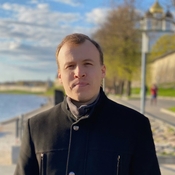Theoretical seminar | 22 March 2023
Online

The present constraint (up to recent time) on the space parity P and time-reflection invariance T violating the electron electric dipole moment (eEDM) is based on the observation of the electron-spin precession in an external electric field using the ThO molecule [1] (~10^{-29} e cm). Until recently, a new upper bound for the eEDM (improvement by a factor ~ 2.4) was established in an experiment with the trapped molecular ions HfF+ in rotating electric field [2]. Still, there is a wide gap between the theoretical predictions of the Standard Model (see, e.g., Ref. [3] and references therein) and the experimental constraints on the eEDM. Therefore, it is highly desirable to develop another type of methods for the eEDM measurements such as that based on the T, P-odd Faraday rotation. The T, P-odd Faraday effect manifests itself as a rotation of the polarization plane of linearly polarized light propagating through a gas medium in an external electric field. Our alternative approach is to observe such an effect using the cavity-enhanced polarimetric scheme in combination with a molecular beam crossing the cavity. Theoretical simulation of the proposed experiment with the PbF and ThO molecular beams shows that the present constraint on the eEDM in principle can be improved by a few orders of magnitude [4].
[1] V. Andreev et al. (ACME collaboration), Nature 562, 355 (2018).
[2] T. S. Roussy et al. (JILA Collaboration), arXiv:2212.11841v3.
[3] Y. Ema, T. Gao, and M. Pospelov, PRL 129, 231801 (2022).
[4] D. V. Chubukov, L. V. Skripnikov, A. N. Petrov, V. N. Kutuzov, and L. N. Labzowsky, PRA 103, 042802 (2021).
